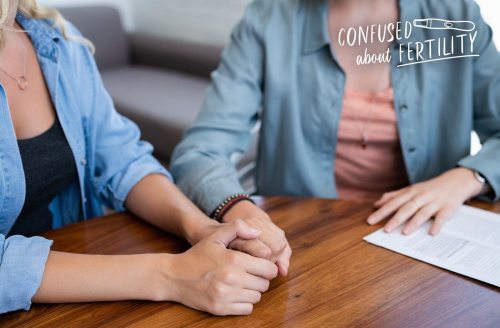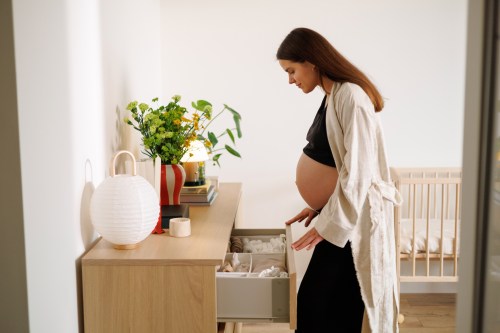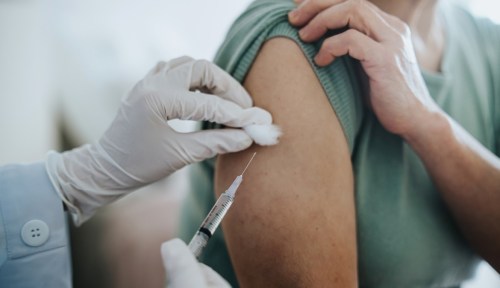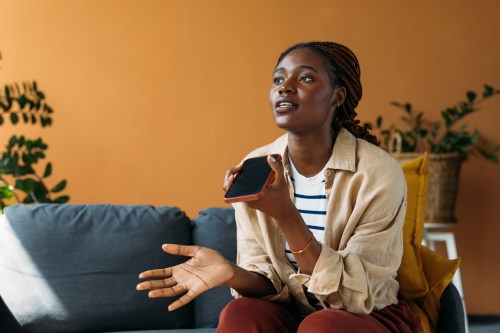Thirty-three percent of U.S. adults have either used fertility treatments or know someone who has, reports Pew Research Center. But if you’re a member of the LGBTQ+ community, the process of seeking medical help for pregnancy—which is hard regardless—becomes exponentially more challenging.
Mere Abrams, LCSW, a gender researcher and licensed mental health professional who identifies as transgender and non-binary, knows first-hand what it’s like to start a fertility journey in a medical system designed for heteronormative needs. (Abrams uses the pronouns they/them.) “I’ve known that I want to be a parent much longer than I knew what my gender and sexuality were,” Abrams says. “When I decided to take steps to medically affirm my gender at the age of 26, [fertility] really came to the forefront because, at that time, there really wasn’t as much research as there is now about fertility options for trans folks and for folks who are starting hormone therapy.”
Abrams ultimately made the decision to go on a low dose of testosterone to preserve their fertility and keep their uterus, despite their doctor’s recommendations to eventually undergo a hysterectomy. (Twenty-one percent of those who identify as transgender report wanting to keep their uteruses). And three years later, Abrams and their partner started thinking about building the family they’d wanted since childhood.
“I went through the fertility preservation process in the summer of 2018 in order to store my eggs and have that option available… so I had to work really hard to find someone even in the San Francisco Bay area who had experience working with trans patients. This provider was really well-intended, but just didn’t really have a nuanced understanding of non-binary gender,” says Abrams.
Abrams isn’t the only who has felt more isolated than assured when seeking out an affirming provider. Fertility hormone testing company Modern Fertility and LGBTQ+ dating app HER recently surveyed a small group of members about their own knowledge and desires about pregnancy. Even though GLAAD reports that more people than ever identify as LGBTQ+, the data released by Modern Fertility and HER shows that many within the queer community have more questions than answers when it comes to pregnancy and family planning. For example, 80 percent of those surveyed reported not knowing that people with ovaries could use hormone blood tests to estimate their egg count, and 54 percent were not aware of the high cost of one cycle of egg freezing ($5,000).
There’s clearly a “fertility information gap“: a systemic absence of reproductive knowledge among many members of the LGBTQ+ community. But it’s not because this population doesn’t care about fertility. In fact, 63 percent of LGBTQ+ millennials who are thinking about starting a family, according to the Modern Fertility survey. Instead, the LGBTQ+ community is often overlooked or left out of fertility conversations entirely, because the existing industry is catered almost entirely to the needs of straight, cisgender women.
How the language of fertility excludes the LGBTQ+ community
“I would say the number one challenge LGBTQ+ people face [when it comes to fertility] is that everything is written for heterosexual people,” says Nicole Noyes, MD, system chief for reproductive endocrinology and infertility and director of fertility preservation at Northwell Health.
By “everything,” Dr. Noyes means the vast majority of online resources, written information dispersed at fertility clinics, and even patient intake forms. Take the Boston IVF Fertility Clinic’s consent form, which Dr. Noyes says is fairly standard across the fertility industry. From the start, the patient is assumed to be a “woman,” despite the fact that trans men and nonbinary people can also have uteruses—and thus are able to become pregnant. Similarly, World Health Organization and The Mayo Clinic only address women.
Despite being explicit about being non-binary, Abrams experienced being spoken to as if they were a woman in their own search for a fertility provider. “The education process really came from a perspective of what I would imagine they would say to someone who’s like a cisgender woman. And so a lot of the things that they touched on was coming from that experience standpoint,” says Abrams. The lack of nuance in their physician’s office ultimately made them want to avoid repeat visits.
It’s not just an issue in the doctor’s office; many fertility startups also market their products explicitly to cisgender women. Kindbody writes “designed and delivered by women who get it” on its website’s about page, ovulation trackers like Bellabeat use pink Pepto Bismol-inspired color palettes, and Everlywell’s hormone test that assesses ovarian function (crucial for fertility) is branded as a “Women’s Hormone Test”—even though, again, trans men and nonbinary people can have ovaries and uteruses.
Dr. Noyes, who helped rewrite Northwell’s Health’s patient intake form to be more inclusive, says that’s not the only oversight. “You can’t even just assume there’s ‘a’ patient. Because if there’s two people there, they might both be patients in some capacity, right? Maybe one person is carrying the pregnancy and the other person’s giving the egg. So it’s not patient and partner; it’s patient and patient. They’re equal,” says Dr. Noyes. Not everyone’s experience gets air time on these forms, and Dr. Noyes says that oversight makes people feel unsupported in the beginning of an already intense time of their lives.
“The reality is that my fertility journey was hard and triggered mental health symptoms I thought were behind me.” —Mere Abrams, LCSW
Nataki Douglas, MD, a reproductive endocrinology and infertility specialist and chair of Modern Fertility, says that being excluded from the language of fertility means is that there’s no one to turn to for information that’s applicable to you and your situation. “There’s limited access to an affirming healthcare system, so LGBTQ+ individuals may have difficulty accessing healthcare providers that proactively and effectively support LGBTQ+ needs,” says Dr. Douglas—including, yes, fertility treatments.
Abrams certainly felt the lack of affirming care in their own journey. “There wasn’t really any discussion about gender dysphoria, and the mental health and psychological impacts of going on fertility hormone therapy, and all of the other things that might come up for a trans or non-binary person as they’re going through this process,” says Abrams. “Everything from daily internal ultrasounds and follicle measurements to multiple injections of hormones that are doing the opposite things to my body than the hormones I would typically put in my body do.” That was emotionally incredibly difficult for Abrams, but was never adequately addressed by their care providers during the process.
“The reality is that my fertility journey was hard and triggered mental health symptoms I thought were behind me,” they say. “No one cautioned me that the egg harvesting procedure could be more emotionally taxing and physically uncomfortable than top surgery. And I felt shame opening up about how psychologically and physically challenging the entire process was for me— because ultimately it is a huge privilege to have access to fertility preservation options.”
Again, Abrams’ story echoes the voices of countless people who are excluded from the current fertility narrative. A whopping 46 percent of all respondents in the Modern Fertility survey reported not feeling comfortable talking to a healthcare provider about their family planning.
Where we go from here
Dr. Douglas says that doctors and the other personnel working in fertility clinics need to do the legwork to close the fertility information gap. “We need a broad adoption of inclusive, affirming reproductive healthcare practices. This includes the appropriate selection of pronouns—and asking for preferred pronouns for all individuals—knowledge of how various gender and sexual identities can impact reproductive health, and proactive support of LGBTQ+ individuals placed prominently on websites,” says Dr. Douglas.
A positive place to start could be doctors and health care providers making their language LGBTQ+-affirming by using GLAAD’s recommendations. For example, using “gay” as an adjective rather than a noun, and acknowledging the difference between gender identity and sexual orientation. When assumptions and prejudices are stripped from the fertility conversation, it can become more inclusive.
There are also fertility companies specifically working to address these needs. Abrams and their wife worked with Mosie Baby, a home insemination company making affordable and inclusive kits, to have their first child (who is due in just six weeks). “We were on our honeymoon and we decided to do it on our honeymoon,” says Abrams. “We were actually up in like Newfoundland, Canada, in a very remote cabin, and it was this really beautiful thing because, going back to like those childhood dreams, I never envisioned that I would ever be able to make a baby in bed with my partner as a queer trans person. If you would have told me, I would have said that was impossible.”
“We need broad adoption of inclusive, affirming reproductive healthcare practices.” —Nataki Douglas, MD, chair of Modern Fertility
Many clinics have begun posting statements of inclusivity and asking their doctors to enact them during the appointment, but that’s certainly not consistently true across the United States. Non-discrimination laws vary greatly in the United States, which makes it all the more important for health care professionals to make their offices at space where many kinds of relationship dynamics are understood. “Whenever possible, it’s also really helpful to have LGBTQ+ representation within the clinics, but inclusive practices are the important first step,” says Dr. Douglas.
One day, Abrams hopes that everyone can feel the autonomy they and their wife felt at the very end of their fertility journey. “The fact that we found an option that was affordable, and that worked for us and allowed us to have that family-building experience that we wanted, was pretty special,” says Abrams, “It’s going to be a fun story to tell this little one once they get older.”
For LGTBQ+ fertility resources, find an affirming clinic near you.
IVF is still illegal in France for gay couples—here’s how one woman and her wife had a baby. Plus, the 10 myths about fertility to stop believing right now.
Sign Up for Our Daily Newsletter
Get all the latest in wellness, trends, food, fitness, beauty, and more delivered right to your inbox.
Got it, you've been added to our email list.











